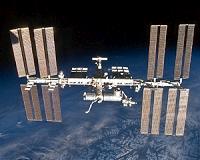 |
Washington DC (SPX) Mar 09, 2011 The Payload Operations Center at NASA's Marshall Space Flight Center in Huntsville, Ala., is celebrating a decade of round-the-clock support to the International Space Station. On March 8, 2001, the Payload Operations Center went online as the science command post for the space station. It links Earth-bound researchers with their experiments - or payloads - in orbit. The job of coordinating space station research is critical because the team is managing all U.S. science assets and calculating the time and space required to accommodate experiments and programs, including those of International Partners. For 10 years, the Payload Operations Center team at the Marshall Center has supported more than 6,000 hours of science experiments conducted by 41 space station crew members, and coordinated more than 1,100 experiments aboard the orbiting outpost. "It's our mission to ensure each crew member has the knowledge and the resources they need on-orbit to achieve the highest possible science results," said Lybrease Woodard, manager of Marshall's Payload Directors' Office. "The crews and scientists have been remarkable to work with. This milestone is a tribute to everyone who has supported payload operations, whether as part of the flight control cadre, ground operations or planners - it's a big team effort." When the Payload Operations Center opened for business at Marshall, many processes were still being developed. Yet the team's prior experiences supporting Spacelab - science missions carried out in the space shuttle's payload bay in the 1990s - helped them transition more quickly into support of the space station. "Our experiences with Spacelab really led to our success," recounted Pat Patterson, a Payloads Operations manager who in 2001 was director of the first shift of flight controllers at Marshall. "Spacelab was our roadmap, but with a continuous laboratory we have gone so much further. We know that those people orbiting 220 miles above Earth count on us, and so do the researchers here on Earth." By serving as virtually an extra space station crew member, the team of ground-based flight controllers helps increase experiment efficiency which saves precious crew time for operations that require a human touch. The Payload Operations Center can send commands to the space station as fast as eight per second. Since 2001, more than 870,000 commands have been sent to payloads. With the help of the payload operations team, orbiting crew members and the scientists on the ground accomplish their science goals, and have produced and published more than 300 results papers from science experiments aboard the station. "That's what our work is all about, doing everything we can to ensure scientists get the results with a well-operated laboratory," said Julie Robinson, International Space Station Program scientist at Johnson Space Center in Houston. "In previous Spacelab days, it was all for just two weeks of opportunity. Now the operations center supports hundreds of experiments around the clock. They are masters of coordinating research operations in space at a level never done before."
Share This Article With Planet Earth
Related Links International Space Station Program Science Office Station at NASA Station and More at Roscosmos S.P. Korolev RSC Energia Watch NASA TV via Space.TV Space Station News at Space-Travel.Com
 We Can See Clearly Now: ISS Window Observational Research Facility
We Can See Clearly Now: ISS Window Observational Research FacilityWashington DC (SPX) Mar 09, 2011 Like a human who just went through laser vision correction, the International Space Station (ISS) recently got a clearer view of our world. That improved view is opening up new vistas for students in American classrooms. The Window Observational Research Facility (WORF) was delivered to the ISS in April 2010 on the STS-131 mission of Space Shuttle Discovery. It was installed and prepped on ... read more |
|
| The content herein, unless otherwise known to be public domain, are Copyright 1995-2010 - SpaceDaily. AFP and UPI Wire Stories are copyright Agence France-Presse and United Press International. ESA Portal Reports are copyright European Space Agency. All NASA sourced material is public domain. Additional copyrights may apply in whole or part to other bona fide parties. Advertising does not imply endorsement,agreement or approval of any opinions, statements or information provided by SpaceDaily on any Web page published or hosted by SpaceDaily. Privacy Statement |